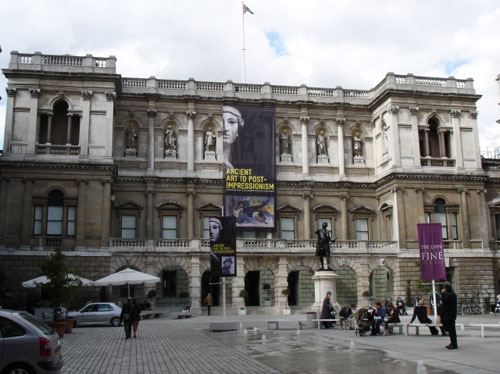Burlington House
 London's Royal Palaces & Attractions London's Royal Palaces & Attractions
with Burlington Bertie .

Burlington House. Wikipedia photo.
Burlington House stands on the north side of Piccadilly between Old Bond Street and Sackville Street. It has had an eventful history since it was first built as a private country mansion in 1665 shortly after the Restoration of Stuart King Charles II. Piccadilly was then a verdant country lane connecting the still predominently medieval city of London with the frequently impassable gulf of mud at Knightsbridge and the dangers of the highwayman-infested road to Exeter and the West. It takes its name from Lord Burlington, whose family acquired it at the turn of the 18th century, and its Palladian architectural splendour from Richard Boyle, third Earl of Burlington. He had the frontage redesigned in 1716 and almost single-handedly succeeded in uprooting the Stuart classicism of English Baroque espoused by St. Paul's Cathedral architect Sir Christopher Wren and his protegees on the rebuilding of London after the Great fire of 1666, to establish the late Italian Renaissance ideals of Palladio as the Georgian architectural norm for the next 100 years.
Lord Burlington's inspiration can be seen in the Palladian grandeur of William Kent's Horse Guards Parade frontages at the eastern end of St. James's Park, (1733-59); Spencer House, John Vardy's magnificent Palladian mansion overlooking Green Park, (1756-65); Sir William Chambers palatial Somerset House in the Strand, (commenced 1776); and the London's fine Georgian town houses such as Kent's 44 Berkeley Square, (now Annabels, the achingly expensive members-only nightclub/restaurant and Clermont Casino). However, little of Burlington's own work in central London has survived the depredations of time, taste and war other than Burlington House, which was considerably altered and extended in the 19th century.
The house was a cultured centre of music, arts and learning under Lord Burlington's patronage and it is appropriate that the Government, which bought the house in 1854, should have perpetuated his inspired concepts. The main block is home to the Royal Academy of Arts which holds immensely popular temporary exhibitions as well as its famed annual June - August Summer Show. The 19th century side and south blocks, which overlook the courtyard, are home to the Geological, Linnean and the Antiquarian Societies of London, the Royal Astronomical Society and the Royal Society of Chemistry.
Burlington Bertie's Verdict
IThe courtyard, which is frequently used for exhibitions of sculpture, is open to the public during the day, as are the restored reception rooms on the main block's first floor. Known as the "John Madejski Fine Rooms", they contain the Academy's permanent collection of works by past and present Royal Academicians, and small temporary exhibitions drawn from this collection. Access is free and a most rewarding hour will be spent here. Interesting Talks exploring and spotlighting works in the collection are given Tuesdays - Saturdays. Enjoy a light meal or a relaxed coffee in the courtyard cafe during the summer months.
The Royal Academy's 1768 charter laid down that it should maintain a Library of Books of Architecture, Sculpture, Painting, and all the Sciences relating thereto; also prints of bas-reliefs, vases, trophies, ornaments, dresses, ancient and modern customs and ceremonies, instruments of war and arts, utensils of sacrifice, and all other things useful to Students in the Arts. Over 230 years this has become a priceless archive and a treasure trove of source and reference material. Members of the public may visit by appointment.
The R.A's major exhibitions are ticketed and usually spectacular events, though the gallery rooms themselves are featureless.
The Linnean Society of London's quarters hold a priceless collection of 14,000 plants, 158 fish, 1,564 shells, 3,198 insects, 1,600 books and 3,000 letters and documents. These can can be viewed by appointment.
London Transport: Nearest Tube. Green Park, Piccadilly Circus
Related Links
R.A.Ticketed and Free Exhibitions and Events. Opening Times.
R.A.Collections
R.A. Research Library and Archive
Linnean Society of London
.
|